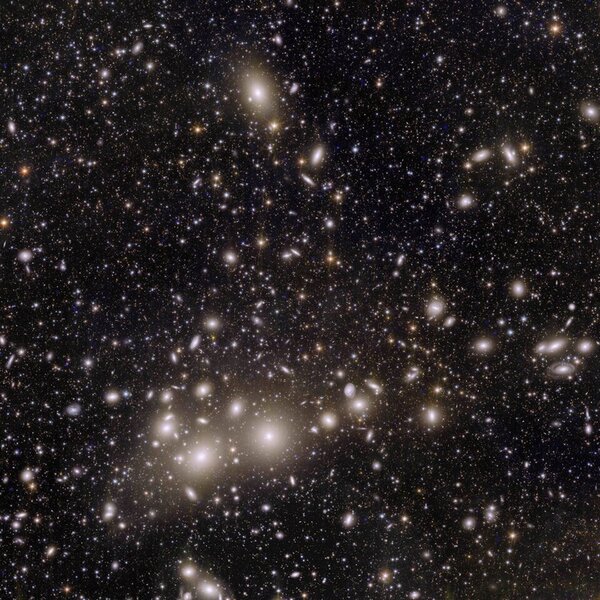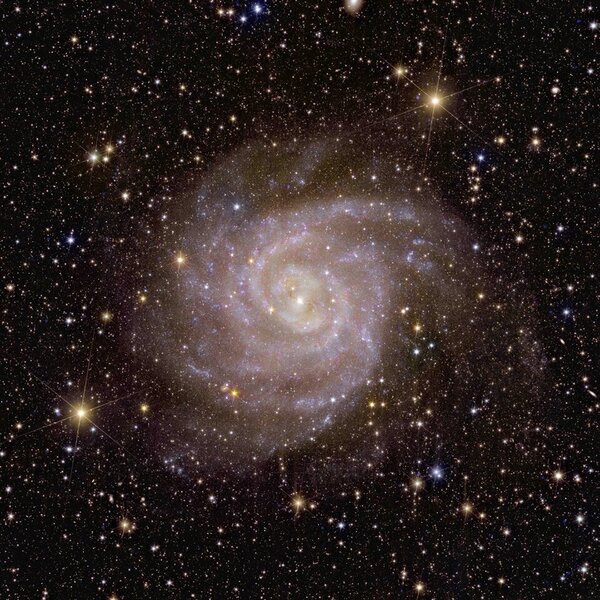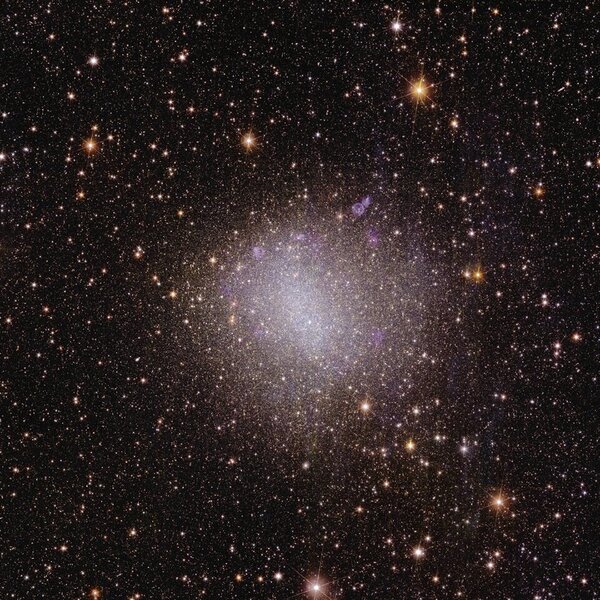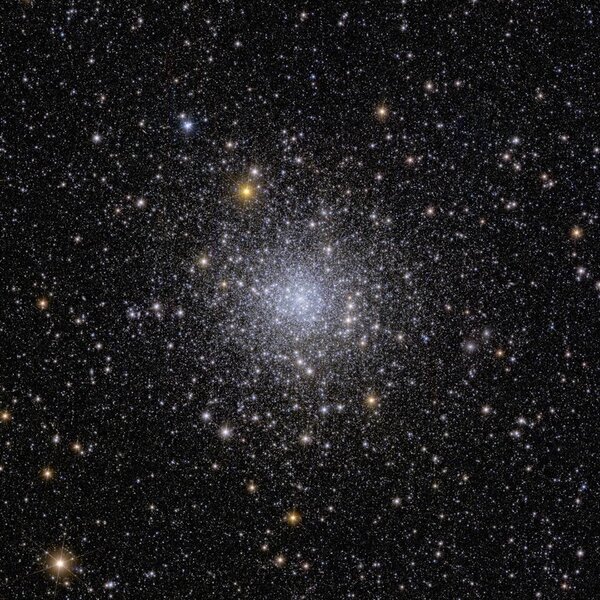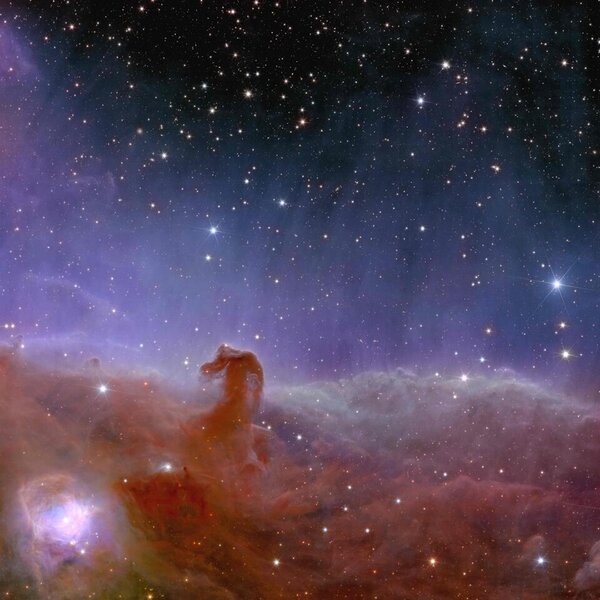Create a free profile to get unlimited access to exclusive videos, sweepstakes, and more!
See the First Astounding Images from the Euclid Dark Matter Telescope
My god, it's full of stars.
In 1999, astronaut John Crichton (Ben Browder) found himself unintentionally transported to the distant reaches of the cosmos in Farscape (streaming now on Peacock). Barring accidentally falling into a wormhole to the other side of the universe, in the real world, we are dependent on our telescopes to do our deep space exploring for us.
Fortunately, we have a new tool at our disposal in the European Space Agency’s (ESA’s) newest dark matter observatory, the Euclid space telescope. Euclid’s goal is pretty lofty, hoping to solve the mysteries of dark matter and dark energy, or at least shine a little more light on them. See, understanding the universe really means understanding dark matter and dark energy.
RELATED: Dark Matter May Have Come from a Second, Darker Big Bang
For every bit of visible matter in the universe, every star, planet, black hole, nebula, and galaxy we’ve ever seen through a telescope, there are another five bits of invisible stuff we call dark matter. We know it’s there because of its gravitational influence – in fact, many structures in the universe from galaxies to star clusters couldn’t hold themselves together without it – but it has otherwise eluded our grasp.
Collectively, all of the matter and dark matter make up only about a quarter of all the stuff in the universe. Everything else is dark energy. Those names are really little more than placeholders for cosmic phenomena we don’t yet understand. Euclid’s goal is to chip away at the great cosmic enigma by constructing the largest 3D map of the universe ever created.
Euclid will map the positions of galaxies and other cosmic objects in both time and space to a distance of 10 billion light-years. The hope is that a more complete map might help us understand the position and behavior of dark matter and dark energy in our universe. The mission will take the next six years, but in the meantime, Euclid has just sent back its first five full-color images.
Check out the First Images Sent Back from the ESA's Euclid Space Telescope
The Perseus Cluster of Galaxies
Located approximately 240 million light-years from here, the Perseus cluster is one of the largest structures in the known universe. The Euclid image shows approximately 1,000 galaxies actually in the Perseus cluster with an additional 100,000 galaxies painted across the background. Some of those galaxies are as much as 10 billion light-years away and have never been observed before.
This cluster is of particular interest because clusters like this one can only have formed if considerable stores of dark matter helped to hold them together. Our current models suggest that dark matter creates invisible filaments through the universe which act as anchor points for galaxies to latch onto.
“If no dark matter existed, galaxies would be distributed evenly throughout the Universe,” said Euclid Consortium scientist Jean-Charles Cuillandre, in a statement.
Spiral Galaxy IC 342
Turning its attention from a galaxy cluster to just one galaxy, Euclid spent about an hour observing the spiral galaxy IC 342, affectionately called the Hidden Galaxy. It was given that name because IC 342 is tucked behind the disc of the Milky Way, obscured from our point of view by a thick wall of gas, dust, and nearby stars.
Euclid’s near-infrared instrument allowed it to cut through the dust and gas to see the galaxy beyond. The Hidden Galaxy is located about 11 million light-years from here, and even at that distance it takes up a lot of space. If you could see it with the naked eye, IC 342 would be about as large as the full Moon in the night sky. And yet, it is too distant and too faint for us to see without specialized equipment.
RELATED: Dark Matter May Have Come From a Second, Darker Big Bang
“That’s what is so brilliant about Euclid images. In one shot, it can see the whole galaxy in all its beautiful detail,” said Euclid Consortium scientist Leslie Hunt, in a statement. “This image might look normal, as if every telescope can make such an image, but that is not true. What’s so special here is that we have a wide view covering the entire galaxy, but we can also zoom in to distinguish single stars and star clusters. This makes it possible to trace the history of star formation and better understand how stars formed and evolved over the lifetime of the galaxy.”
Irregular Galaxy NGC 6822
Our own Milky Way galaxy is nice and fancy, sprawled out in a set of glorious spiral arms which bound around the supermassive black hole at the galactic center. We have a snazzy galaxy, the kind you want to take pictures of and get tattooed on your arm, but not all galaxies are so fortunate. Those galaxies less massive than ours aren’t as fun to look at, but they are just as important for cosmic evolution.
Blobby, irregular galaxies are the foundation of the universe, providing themselves as building blocks for the conglomeration of more massive, more impressive galaxies like ours. Euclid zoomed in on one such galaxy, the irregular smear of stars called NGC 6822, roughly 1.6 million light-years from here.
Despite being relatively nondescript, NGC 6822 is of particular note because it’s one of our own galactic siblings, a member of the Local Group, the same galaxy cluster we belong to. Euclid observed the galaxy for about an hour, capturing way more light than would be possible from the ground. It's the first observatory to image the entire galaxy and its surroundings in high definition.
Globular Cluster NGC 6397
The cluster NGC 6397 is the second closest globular cluster to Earth at a distance of roughly 7,800 light-years. The cluster consists of thousands of stars all gravitationally bound to one another like marbles dropped onto a trampoline.
Star clusters come in two main types. First you have open clusters, usually made up of roughly 100 stars or so loosely collected into a group. Globular clusters are like star clusters cranked to 11. These groups can contain hundreds of thousands of stars all tightly bound together, which can make them difficult to observe as a single object.
RELATED: Dark matter planets might exist, and we have ways to find them
“Currently no other telescope than Euclid can observe the entire globular cluster and at the same time distinguish its faint stellar members in the outer regions from other cosmic sources,” explains Euclid Consortium scientist Davide Massari, in a statement.
Researchers hope Euclid will reveal tidal tails inside globular clusters indicative of nearby dark matter. Euclid aims to figure out how these clusters orbit the rest of the Milky Way, revealing how dark matter is distributed throughout our galaxy.
The Horsehead Nebula
The Horsehead Nebula is one of the most easily recognized and heavily observed objects in the night sky. Located in the constellation Orion, the Horsehead Nebula is part of a gigantic star forming region roughly 1,375 light-years from here. The nebula is perched just south of Alnitak, the easternmost star in Orion’s belt.
Euclid captured the image with only about an hour of observing time, a fairly standard length of time for all of the images in the first release. The results highlight the power the telescope can achieve in even short observing periods. In addition to providing a sharper picture than ever before, Euclid hopes to find previously undiscovered Jupiter-mass planets alongside fledgling stars still in the process of developing.
And along the way it will map out everything else it can see between here and 10 billion light-years away, sniffing out dark matter and dark energy wherever it can be found. Maybe it’ll even figure out whatever happened to John Crichton.
Catch Farscape streaming now on Peacock.




